What Does a "Baby" Muennink Spiny Rat Look Like
The house mouse (Mus musculus) is a modest rodent, a mouse, i of the most numerous species of the genus Mus.
Every bit a wild animal the house mouse mainly lives associated with humans, causing harm to crops and stored food.
The business firm mouse has been domesticated as the pet or fancy mouse, and every bit the laboratory mouse which is one of the most important model organisms in biology and medicine. It is by far the about ordinarily used genetically altered laboratory mammal. [2]
Contents
- i Characteristics
- 2 Subspecies
- 3 Behaviour
- 3.one Senses and communication
- iii.two Life bicycle and reproduction
- iii.2.i Sleep
- 3.3 Life expectancy
- 4 Mice and humans
- 4.1 Mice as an invasive species
- five Laboratory mice
- five.1 Genome
- 5.ii T-haplotype
- 5.three Mutant and transgenic strains
- 5.4 Injection procedures
- 5.5 Anesthesia
- vi Notes
- 7 References
- 8 External links
Characteristics
Business firm mice have an adult body length (nose to base of tail) of 7.five–10 cm (iii.0–3.9 in) and a tail length of v–10 cm (2.0–3.9 in). The weight is typically 10–25 g (0.4–0.ix oz). They vary in colour from white to greyness, and calorie-free brown to black. They have short hair and a light belly. The ears and tail have lilliputian pilus. The hind feet are short compared to Apodemus mice, only 15–19 mm (0.59–0.75 in) long; the normal gait is a run with a footstep of about 4.5 cm (1.8 in), though they can bound vertically up to 45 cm (eighteen in). [3] The droppings are blackish, well-nigh 3 mm (0.12 in) long,[ commendation needed ] and have a potent musty smell. The voice is a high-pitched squeak. [4] [5]
Business firm mice thrive under a variety of conditions: they are found in and around homes and commercial structures equally well as in open up fields and agricultural lands. House mice consume and contaminate nutrient, pet food and animal feed. In improver, they often crusade considerable agricultural and holding damage. They as well transmit disease-causing pathogens and parasites. [6]

![]()
Reconstructed prototype of a House Mouse skull.
Young males and females are not easily distinguished: like people, females have a significantly smaller distance between their anus and genital opening. Females have 5 pairs of mammary glands and nipples; males have no nipples. [7] When sexually mature, the most striking and obvious difference is the presence of testicles on the males. These are large compared to the rest of the body and can be retracted into the body. In addition to the regular pea-size thymus organ in the chest, house mice have a 2d functional pinhead-size thymus organ in the neck adjacent to the trachea. [8]
Subspecies
There are 3 widely accepted subspecies, increasingly treated as distinct species: [nine] [10]
- Mus musculus castaneus (southern and southeastern Asia *Photograph)
- Mus musculus domesticus (western Europe, southwestern Asia, Americas, Africa, and Oceania)
- Mus musculus musculus (eastern Europe and northern Asia)
Two boosted subspecies have been more recently recognized: [10]
- Mus musculus bactrianus (primal Asia)
- Mus musculus gentilulus (Arabian Peninsula; Republic of madagascar) [xi]
Many more names accept been given to house mice, but are now regarded every bit synonyms of other subspecies. Some populations are hybrids of different subspecies, including the Japanese firm mouse ("molossinus"). [x] [12]
Behaviour
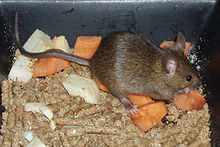
![]()
Eating
House mice ordinarily run, walk, or stand on all fours, but when eating, fighting, or orienting themselves, they stand just on the hind legs, supported by the tail. When they run, the horizontal tail serves for balance; the end stands upward vertically, unless the mouse is frightened. Mice are skillful jumpers, climbers, and swimmers.
Mice are mostly active during dusk or nighttime; they do not like brilliant lights. They live in a wide variety of hidden places that are near food sources and construct nests from various soft materials. Mice are territorial, and one dominant male usually lives together with several females and young. Ascendant males respect each other's territory and normally enter another's territory only if information technology is vacant. If two or more males are held together in a cage, they will often turn aggressive unless they have been raised together from nativity.
Business firm mice primarily feed on institute matter just are omnivorous. They will swallow their droppings to acquire nutrients produced by bacteria in their intestines. House mice, similar most other rodents, exercise non vomit.
Mice are agape of rats, which oft kill and (partially) consume mice. This rat behaviour is known every bit muricide. Despite this behaviour free-living populations of rats and mice practice exist together in forest areas in New Zealand, N America and elsewhere. House mice are generally poor competitors and in almost areas cannot survive away from homo settlements in areas where other small mammals, such as wood mice, are present. [xiii] All the same, in some areas (such as Australia), mice are able to co-be with other small-scale rodent species. [xiv]
Senses and communication
As primarily nocturnal animals, business firm mice accept trivial or no colour vision. They have a precipitous sense of hearing and tin can perceive ultrasound, possibly upwardly to 100 kHz. They communicate both in the human audible range with squeaks (for long-distance warnings), and in the ultrasound range (for short-altitude communication).[ citation needed ]
Firm mice also rely on pheromones for social communication, some of which are produced by the preputial glands of both sexes. The tear fluid and urine of male mice likewise contains pheromones, such every bit major urinary proteins. [xv] [16] Mice detect pheromones mainly with the vomeronasal organ (Jacobson'due south organ), located at the bottom of the nose.
The urine of house mice, especially that of males, has a characteristic strong aroma. At to the lowest degree ten different compounds such as alkanes, alcohols, etc. are detectable in the urine. Amid the ten, five compounds are specific to males, namely 3-cyclohexene-1-methanol, Aminotriazole (3-amino-due south-triazole), 4-ethyl phenol, iii-ethyl-two,7-dimethyl octane and 1-iodoundecane. [17]
Mice can sense surfaces and air movements with their whiskers.
Life wheel and reproduction
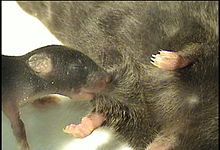
![]()
A 7-day-erstwhile mouse suckling on an anaesthetized mother.
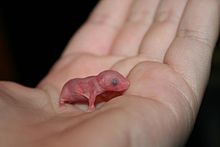
![]()
A infant mouse, iv days quondam.
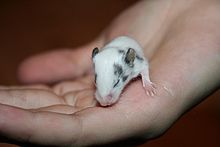
![]()
2 weeks erstwhile, just about to open its eyes.
Female house mice have an estrous cycle that is iv–6 days long, with estrus itself lasting less than a day. If several females are held together under crowded atmospheric condition, they volition often not have an estrus at all. If they are then exposed to male person urine, they will get estrous afterward 72 hours.
Male house mice court females by emitting characteristic ultrasonic calls in the 30 kHz–110 kHz range. The calls are most frequent during courting when the male person is sniffing and post-obit the female person; nevertheless, the calls go on after mating has begun at which time the calls are coincident with mounting behaviour. Males can be induced to emit these calls by female pheromones. The vocalizations appear to be unlike in dissimilar individuals and have been compared to birdsongs because of their complication. [18] While females take the capability to produce ultrasonic calls, they typically do non practice and so during mating behaviour.
Post-obit copulation, female person mice will normally develop a vaginal plug which prevents further copulation. This plug stays in place for some 24 hours. The gestation flow is about nineteen–21 days, and they requite birth to a litter of three–14 young (boilerplate 6–8). One female person can have some 5–10 litters per year, so the mice population tin can increase very quickly. Convenance occurs throughout the year (nevertheless, animals living in the wild don't reproduce in the colder months, even though they don't hibernate). The newborn are blind and without fur. Fur starts to abound some three days later nascency and the eyes open ane to 2 weeks after birth. Females attain sexual maturity at almost 6 weeks and males at most 8 weeks, only both can breed as early as five weeks.
Slumber
The boilerplate slumber time of a convict Business firm mouse is said[ by whom? ] to be 12½ hours per day. [19]
Life expectancy
Firm mice usually alive under a year in the wild. This is due to a high level of predation and exposure to harsh environments. In protected environments, however, they oft live two to three years. The Methuselah Mouse Prize is a competition to breed or engineer extremely long-lived laboratory mice. As of 2005[update], the tape holder was a genetically engineered mouse that lived for 1819 days (nearly five years). Another record holder that was kept in a stimulating surround only did not receive any genetic, pharmacological, or dietary handling lived for 1551 days (over four years).
Mice and humans
House mice usually live in proximity to humans, in or around houses or fields. Originally native to Asia (probably northern India), [20] they spread to the Mediterranean Basin about 8000 BC, simply spreading into the rest of Europe around 1000 BC. [21] This time lag is thought to be considering the mice require agrarian human settlements in a higher place a certain size. [21] They accept since been spread to all parts of the globe by humans.
Many studies have been done on mouse phylogenies to reconstruct early on man movements. For example one study showed a previously unsuspected early link between Denmark and Madeira on the basis of the origin of the Madeiran mice. [22]
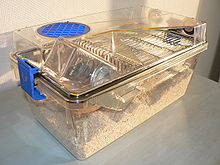
![]()
An individually ventilated and sealed cage for laboratory mice
House mice can transmit diseases, and can damage food and food packaging. Some of the diseases the house mouse carries can be deadly: for instance, Murine typhus, Rickettsialpox, Tularemia, and the Bubonic plague.[ citation needed ] House mice can too cause substantial harm when feeding on grain. It is thought that house mice were the master reason for the taming of the domestic true cat. Various mousetraps accept been developed to catch mice. Mostly, rats are more harmful to humans than mice.[ citation needed ] [ clarification needed ]
The first written reference to mice kept as pets occurs in the Erya, the oldest extant Chinese dictionary, from a mention in an 1100 B.C. version. [23] Homo domestication led to numerous strains of "fancy" or hobby mice with a variety of colours and a docile temperament. [24] Domestic varieties of the business firm mouse called "feeder" mice are too used as food for some cannibal pet reptiles, birds, arthropods, and fish. Mice bred for this purpose are genetically identical to other domestic mice, and they tin be kept as pets themselves. [24]
Mice equally an invasive species
Gough Isle in the South Atlantic is used by twenty species of seabird for breeding, including almost all of the earth's Tristan Boundness (Diomedea dabbenena) and Atlantic Petrel (Pterodroma incerta). Until house mice arrived on the island in the 19th century with seamen, the birds did not take any mammalian predators. The mice have since grown unusually large and have learned to assault albatross chicks, which can be nearly i metre tall only are largely immobile, by working in groups and gnawing on them until they bleed to decease. The estimated 700,000 mice on the island impale a full of over 1 million bird chicks per twelvemonth. [25]
Laboratory mice
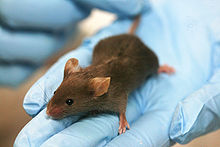
![]()
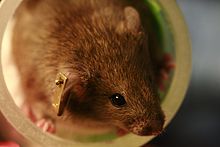
![]()
Mice are the near unremarkably used animal research model with hundreds of established inbred, outbred, and transgenic strains. In the Us, they are not regulated under the Animal Welfare Deed (AWA) administered past the USDA APHIS. Still, the Public Wellness Service Act (PHS) equally administered past the National Institutes of Health (NIH) does offering a standard for care and use. Compliance with PHS is required in order to receive federal funding. PHS Policy is administered past the Office of Laboratory Animal Welfare (OLAW). Many academic enquiry institutes seek accreditation voluntarily, often through Association for Cess and Accreditation of Laboratory Animal Care (AAALAC), which maintains the standards of care found within The Guide for the Care and Utilize of Laboratory Animals and the PHS Policy. This accreditation is voluntary non a prerequisite for federal funding. [26]
Mice are common experimental animals in biology and psychology; primarily because they are mammals, are relatively easy to maintain and handle, reproduce quickly, and share a high degree of homology with humans. The mouse genome has been sequenced, and many mouse genes have human homologues.
In addition to being small, relatively cheap, and easily maintained, there are further benefits to the use of mice in laboratory research. Because mice can reproduce speedily, several generations of mice tin can exist observed in a relatively curt menses of time. [27]
Near laboratory mice are hybrids of dissimilar subspecies, virtually commonly of Mus musculus domesticus and Mus musculus musculus. Laboratory mice come up in a variety of coat colours including agouti, black and albino. Many (but not all) laboratory strains are inbred, then as to brand them genetically near identical. The different strains are identified with specific letter of the alphabet-digit combinations; for example C57BL/six and BALB/c.
The first such inbred strains were produced by Clarence Melt Piffling in 1909. Picayune was influential in promoting the mouse every bit a laboratory organism. [28]
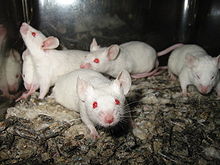
![]()
Albino lab mice
Genome
Sequencing of the mouse genome was completed in late 2002. The haploid genome is about iii billion bases long (3000 Mb distributed over xx chromosomes) and therefore equal to the size of the human genome. [29] Estimating the number of genes contained in the mouse genome is difficult, in part because the definition of a gene is nonetheless existence debated and extended. The electric current estimated gene count is 23,786. [30] This estimate takes into business relationship knowledge of molecular biology also as comparative genomic information. For comparing, humans are estimated to have 23,686 genes. [31]
T-haplotype
The t-haplotype is a selfish element that works to disable the function of the wild house mouse, Mus musculus, sperm to ensure the fertilization of the female egg with their own sperm. This gamete killer designed and structured to suppress recombination of genes, is a single unit of measurement, of linked genes, located near the centromere of chromosome 17 and is approximately 30-xl Mb long. [32] I part of the t-haplotype is the responder-insensitive allele Tcr. Tcr gives protection from the distorting drivers, since information technology shows haploid-specific expression, which means that simply sperm that carry the haploid are rescued from existence killed. [33] While advantageous, the frequency of this selfish element is reported equally low. [34]
The low t – haplotype frequency in the wild house mouse population is a paradox. Although +/t male mice carry equal ratios of both gamete types (+ and t) and the wild blazon chromosome becomes functionally inactivated as well as 90% of the offspring inherit the t chromosomes, wild house mouse populations have remained polymorphic. [34] Information technology would be hypothesized that the high TRD, transmission baloney ratio, of t-haplotypes would become stock-still in a natural population, if xc% of the offspring were inheriting the t chromosome, but due to several factors this is not the case. At that place have been investigations of dissimilar subspecies mice populations in different locations. Studies have found that there were low t frequencies in enclosure populations as well equally in different subspecies. Huang et al. (2001) [35] , in Taiwan, observed a low frequency in the subspecies, Mus castaneus, which has also been observed by both Ardlie and Argent (1998) [34] and Carroll et al. (2004). [36] Based on these findings, it can exist assumed that the general mechanisms of these low t frequencies in mouse populations are like across subspecies and geographical location, making the unraveling of this paradox beneficial to not only the Mus domesticus species of mouse, but for other species of mouse such as Mus castaneus.
Explanations for the low frequency of t-haplotypes include factors such as population size, inbreeding, heterozygosity, and polyandry in the wild business firm mouse population.
Mutant and transgenic strains
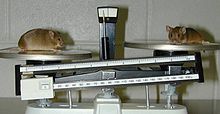
![]()
A knockout mouse (left) that is a model of obesity, compared with a normal mouse.
Various mutant strains of mice have been created by a number of methods:
- Mice resulting from ordinary breeding.
- NOD mice, which develop diabetes mellitus type 1.
- MRL mice, mice with unusual regenerative capacities. [37]
- "Waltzing" mice, which walk in a round pattern due to a mutation adversely affecting their inner ear.
- Immunodeficient nude mice, lacking hair and a thymus. The mice don't produce T lymphocytes and therefore don't mount cellular immune responses. They are used for research in immunology and transplantation.
- Astringent Combined Immunodeficient or SCID mice, with an near completely defective allowed system.
- Transgenic mice, with foreign genes inserted into their genome.
- Abnormally big mice, with an inserted rat growth hormone factor.
- Oncomice, with an activated oncogene, so as to significantly increase the incidence of cancer.
- Doogie mice, with enhanced NMDA receptor role, resulting in improved memory and learning.
- Knockout mice, where a specific factor was made inoperable by a technique known as gene knockout; the purpose is to written report the function of the gene's product or to simulate a human disease.
- Fat mice, prone to obesity due to a carboxypeptidase Eastward-deficiency.
- Strong muscular mice, with a disabled myostatin gene, nicknamed "mighty mice."
Since 1998, information technology has been possible to clone mice from cells derived from adult animals.
Injection procedures
Routes of administration of injections in laboratory mice are mainly subcutaneous, intraperitoneal and intravenous. Intramuscular administration is not recommended due to small muscle mass. [38] Intracerebral administration is also possible. Each procedure has recommended injection site, guess needle estimate and recommended maximal injected volume at a single time at one site, every bit given in table:
| Route | Recommended site [38] | Needle estimate [38] | Maximal volume [39] |
|---|---|---|---|
| subcutaneous | dorsum, betwixt scapula | 25-26 ga | ii-three ml |
| intraperitoneal | left lower quadrant | 25-27 ga | 2-3 ml |
| intravenous | lateral tail vein | 27-28 ga | 0.ii ml |
| intramuscular | hindlimb, caudal thigh | 26-27 ga | 0.05 ml |
| intracerebral | attic | 27 ga |
To facilitate intravenous injection into the tail, laboratory mice can be carefully warmed under rut lamps to vasodilate the vessels. [38]
Anesthesia
A common regimen for general anesthesia for the firm mouse is ketamine (in the dose of 100 mg per kilogram body weight) plus xylazine (in the dose of 5–ten mg/kg), injected past the intraperitoneal route. [40] It has a elapsing of result of about 30 minutes. [twoscore]
Notes
- ^ Musser G, Amori G, Hutterer R, Kryštufek B, Yigit N & Mitsain Thousand (2008). Mus musculus. In: IUCN 2008. IUCN Blood-red List of Threatened Species. Downloaded on ten Oct 2008.
- ^ the National Centre for Replacement, Refinement, and Reduction of Animals in Research
- ^ Bakery RO, Bodman GR, Timm RM (1994). "Rodent-Proof Construction and Exclusion Methods". In Hygnstrom SE, Timm RM, Larson GE. Prevention and Control of Wildlife Damage. University of Nebraska-Lincoln. http://digitalcommons.unl.edu/icwdmhandbook/27/.
- ^ Lyneborg L (1971). Mammals of Europe. Blandford Press.
- ^ Lawrence MJ, & Brownish RW (1974). Mammals of United kingdom Their Tracks, Trails and Signs. Blandford Press.
- ^ 12
- ^ "Julie Ann Mayer, John Foley, Damon De La Cruz, Cheng-Ming Chuong, and Randall Widelitz" ("nov 2008"). ["http://www.ncbi.nlm.nih.gov/pmc/manufactures/PMC2570124/" ""Conversion of the Nipple to Pilus-Bearing Epithelia by Lowering Bone Morphogenetic Protein Pathway Activity at the Dermal-Epidermal Interface""]. "http://www.ncbi.nlm.nih.gov/pmc/articles/PMC2570124/".
- ^ Terszowski K et al., G (2006-03-02). "Evidence for a Functional Second Thymus in Mice". Scientific discipline 312 (5771): 284. doi:10.1126/science.1123497. ISSN 0036-8075. PMID 16513945.
- ^ Mitchell-Jones AJ, Amori G, Bogdanowicz W, Krystufek B, Reijnders PJH, Spitzenberger F, Stubbe M, Thissen JBM, Vohralik V, & Zima J (1999). The Atlas of European Mammals. T. & A. D. Poyser. ISBN 0856611301.
- ^ a b c Musser & Carleton 2005
- ^ Prager EM, Orrego C and Sage RD (1998). "Genetic variation and phylogeography of Key Asian and other business firm mice, including a major new mitochondrial lineage in Yemen". Genetics 150 (2): 835–861. PMC 1460354. PMID 9755213. http://www.pubmedcentral.nih.gov/articlerender.fcgi?tool=pmcentrez&artid=1460354.
- ^ Bonhomme F, Miyashita North, Boursot, Catalan J and Moriwaki Thou (1989). "Genetic variation and polyphyletic origin in Japanese Mus musculus". Heredity 63 (3): 299–308. doi:10.1038/hdy.1989.102. PMID 2613534.
- ^ Tattersall FH, Smith RH & Nowell F (1997). "Experimental colonization of contrasting habitats by house mice". Zeitschrift für Säugetierkunde 62: 350–8.
- ^ Moro D and Morris K (2000). "Movements and refugia of Lakeland Downs short-tailed mice, Leggadina lakedownensis, and firm mice, Mus domesticus, on Thevenard Isle, Western Australia". Wild animals Research 27: xi–20. doi:10.1071/WR99016.
- ^ Kimoto, H; Haga, S; Sato, K; Touhara, Chiliad (October 2005). "Sex-specific peptides from exocrine glands stimulate mouse vomeronasal sensory neurons". Nature 437 (7060): 898–901. doi:10.1038/nature04033. ISSN 0028-0836. PMID 16208374. http://www.nature.com/nature/journal/v437/n7060/abs/nature04033.html.
- ^ Chamero P, Marton TF, Logan DW, et al., P (December 2007). "Identification of protein pheromones that promote aggressive behaviour". Nature 450 (7171): 899–902. doi:x.1038/nature05997. ISSN 0028-0836. PMID 18064011.
- ^ Achiraman Due south & Archunan M, S (Dec 2002). "Label of urinary volatiles in Swiss male person mice (Mus musculus): bioassay of identified compounds". J Biosci 27 (7): 679–86. doi:10.1007/BF02708376. ISSN 0250-5991. PMID 12571373.
- ^ Holy, TE; Guo, Z (December 2005). "Ultrasonic Songs of Male Mice". PLoS Biol 3 (12): e386. doi:10.1371/periodical.pbio.0030386. PMC 1275525. PMID 16248680. http://biology.plosjournals.org/perlserv/?request=get-document&doi=10.1371/journal.pbio.0030386.
- ^ "40 Winks?" Jennifer South. Holland, National Geographic Vol. 220, No. 1. July 2011.
- ^ Boursot P, Din W, Anand R, Darviche D, Dod B, Von Deimling F, Talwar GP and Bonhomme F (1996). "Origin and radiation of the house mouse: mitochondrial DNA phylogeny". Periodical of Evolutionary Biological science 9: 391–415. doi:x.1046/j.1420-9101.1996.9040391.x.
- ^ a b Cucci T, Vigne J-D and Auffray J-C (2005). "First occurrence of the firm mouse (Mus musculus domesticus Schwarz & Schwarz, 1943) in the Western Mediterranean: a zooarchaeological revision of subfossil occurrences". Biological Journal of the Linnean Society 84: 429–445. doi:ten.1111/j.1095-8312.2005.00445.10.
- ^ Gündüz I, Auffray J-C, Britton-Davidian J, Catalan J, Ganem G, Ramalhinho MG, Mathias ML and Searle JB (2001). "Molecular studies on the colonization of the Madeiran archipelago by firm mice". Molecular Ecology 10 (8): 2023–9. doi:ten.1046/j.0962-1083.2001.01346.x. PMID 11555245.
- ^ American Fancy Rat and Mouse Association
- ^ a b the Rat and Mouse Club of America
- ^ Wanless RM, Angel A, Cuthbert RJ, Hilton GM & Ryan PG (2007). "Can predation past invasive mice drive seabird extinctions?". Biological science Letters 3 (3): 241–4. doi:10.1098/rsbl.2007.0120. PMC 2464706. PMID 17412667. http://www.journals.royalsoc.ac.uk/content/110824/.
- ^ "Office of Laboratory Animal Welfare: PHS Policy on Humane Care and Utilize of Laboratory Animals". Grants.nih.gov. http://grants.nih.gov/grants/olaw/references/phspol.htm . Retrieved 2010-07-29.
- ^ "MGI — Biological science of the Laboratory Mouse". Informatics.jax.org. http://www.informatics.jax.org/greenbook/frames/frame11.shtml . Retrieved 2010-07-29.
- ^ Crow JF (August 2002). "C. C. Little, cancer and inbred mice". Genetics 161 (4): 1357–61. PMC 1462216. PMID 12196385. http://www.genetics.org/cgi/content/full/161/4/1357.
- ^ No items found - Books Results
- ^ Ensembl gene build 47, based upon NCBI assembly m37, Apr 2007
- ^ Ensembl cistron build 47, based upon NCBI assembly 36, Oct 2005
- ^ Silver, L. 1993. The peculiar journey of a selfish chromosome: mouse t-haplotypes and meiotic drive. Trends in Genetics 9:250.
- ^ Lyon, One thousand. 2003. Transmission ratio distortion in mice. Annual Review Genetics 37:393-408.
- ^ a b c Ardlie, K., and Fifty. Silver. 1998. Low frequency of t haplotypes in natural populations of house mice (Mus musculus domesticus). Evolution 52: 1185-1196.
- ^ Huang, S. –Westward., Ardlie, K.G., and H.-T. Yu. 2001. Frequency and distribution of t-haplotypes in the southeast asian business firm mouse (Mus musculus castaneus) in Taiwan. Molecular Ecology x:2349-2354.
- ^ Carroll, L., Southward. Meagher, L. Morrison, D. Penn, and Westward. Potts. 2004. Fitness furnishings of a selfish gene (the Mus t complex) are revealed in an ecological context. Development 58:1318–1328.
- ^ "JAX Mice Database — 002983 MRL.CBAJms-Fas/J". Jaxmice.jax.org. http://jaxmice.jax.org/strain/002983.html . Retrieved 2010-07-29.
- ^ a b c d Guidelines for Selecting Route and Needle Size From Duke University and Medical Centre - Animal Care & Use Program. Retrieved April 2011
- ^ A Compendium of Drugs Used for Laboratory Animal Anesthesia, Analgesia, Tranquilization and Restraint at Drexel Academy College of Medicine. Retrieved April 2011
- ^ a b Guidelines for Systemic Anesthetics (Mouse) From Knuckles University and Medical Center - Animal Intendance & Use Program. Retrieved April 2011
References
- Musser, 1000.G.; Carleton, M.D. (2005). "Superfamily Muroidea". In Wilson, D.E.; Reeder, D.M.. Mammal Species of the World: a taxonomic and geographic reference (tertiary ed.). Baltimore: Johns Hopkins Academy Press. pp. 894–1531. ISBN 978-0-8018-8221-0. http://www.bucknell.edu/msw3.
- Nyby J. (2001). "Ch. 1 Auditory communication in adults". In Willott, James F.. Handbook of Mouse Auditory Research: From Behavior to Molecular Biological science. Boca Raton: CRC Press. pp. 3–18.
External links
Taxonomy
- Business firm mouse at the Encyclopedia of Life
- http://www.findmice.org/
Genetics
- House mouse at National Center for Biotechnology Information (NCBI) website.
- Ensembl Mus muscle genome browser, from the Ensembl Project
- Vega Mus musculus genome browser, includes NOD mouse sequence and note
Media
- Pictures, movies and applets showing the anatomy of Mus musculus, from www.digimorph.org
- Michael Purdy: "Researchers add mice to list of creatures that sing in the presence of mates"-Study of male mouse "song" with mouse song recording (MP3), by Washington University Medical School
- Arkive Photographs.Curt text.
- Loftier-Resolution Brain Maps and Encephalon Atlases of Mus musculus
Further reading
- Fact Sheet on House Mice Includes brief overview of habits, habitat, threats and prevention tips
- Biology of the Mouse, from the Louisiana Veterinary Medical Clan
- Nature Mouse Special 2002
- Biology of Laboratory Rodents by David G. Besselsen
- Comprehensive house mouse information, including pictures, by the University of Michigan Museum of Zoology
- 'Fancy Mice', includes much behavioral and physiological information
- Some information on muricide
- Vocalizations during copulation
| Major model organisms in genetics | |
|---|---|
| Sheep· Lambda phage· East. coli· Chlamydomonas· Tetrahymena· Budding yeast· Fission yeast· Neurospora· Maize· Arabidopsis· Medicago truncatula· C. elegans· Drosophila· Xenopus· Zebrafish· Rat· Mouse | |
| Extant species of subfamily Murinae | |||||||||||||||||||||||||||||||||||||||||||||||||||||||||||||||||||||||||||||||||||||||||||||||||||||||||
|---|---|---|---|---|---|---|---|---|---|---|---|---|---|---|---|---|---|---|---|---|---|---|---|---|---|---|---|---|---|---|---|---|---|---|---|---|---|---|---|---|---|---|---|---|---|---|---|---|---|---|---|---|---|---|---|---|---|---|---|---|---|---|---|---|---|---|---|---|---|---|---|---|---|---|---|---|---|---|---|---|---|---|---|---|---|---|---|---|---|---|---|---|---|---|---|---|---|---|---|---|---|---|---|---|---|
| Kingdom: Animalia· Phylum: Chordata· Form: Mammalia· Superorder: Euarchontoglires· Order: Rodentia· Family: Muridae | |||||||||||||||||||||||||||||||||||||||||||||||||||||||||||||||||||||||||||||||||||||||||||||||||||||||||
| |||||||||||||||||||||||||||||||||||||||||||||||||||||||||||||||||||||||||||||||||||||||||||||||||||||||||
| |||||||||||||||||||||||||||||||||||||||||||||||||||||||||||||||||||||||||||||||||||||||||||||||||||||||||
| |||||||||||||||||||||||||||||||||||||||||||||||||||||||||||||||||||||||||||||||||||||||||||||||||||||||||
| |||||||||||||||||||||||||||||||||||||||||||||||||||||||||||||||||||||||||||||||||||||||||||||||||||||||||
| |||||||||||||||||||||||||||||||||||||||||||||||||||||||||||||||||||||||||||||||||||||||||||||||||||||||||
| |||||||||||||||||||||||||||||||||||||||||||||||||||||||||||||||||||||||||||||||||||||||||||||||||||||||||
| |||||||||||||||||||||||||||||||||||||||||||||||||||||||||||||||||||||||||||||||||||||||||||||||||||||||||
| |||||||||||||||||||||||||||||||||||||||||||||||||||||||||||||||||||||||||||||||||||||||||||||||||||||||||
Source: https://en-academic.com/dic.nsf/enwiki/11567202
0 Response to "What Does a "Baby" Muennink Spiny Rat Look Like"
Post a Comment